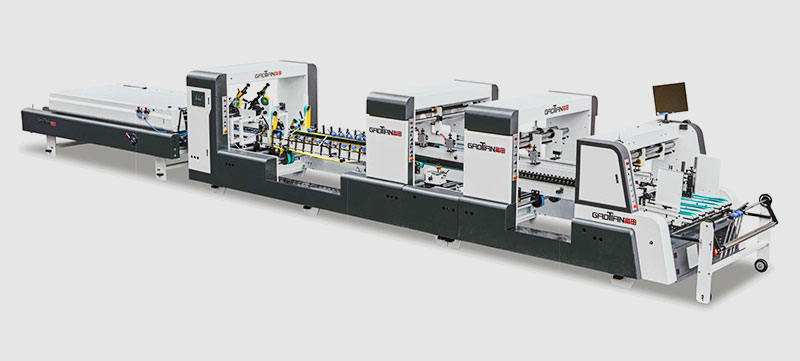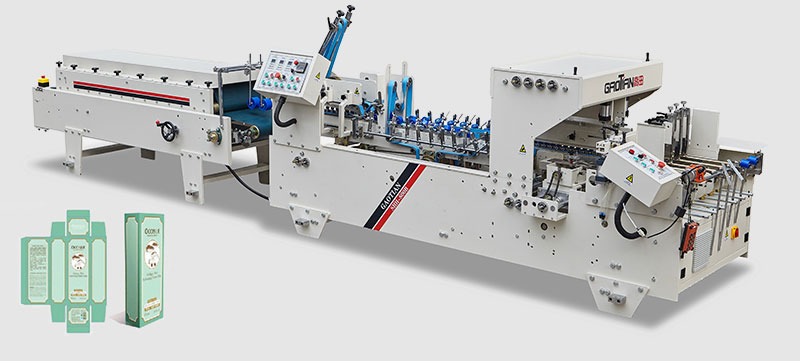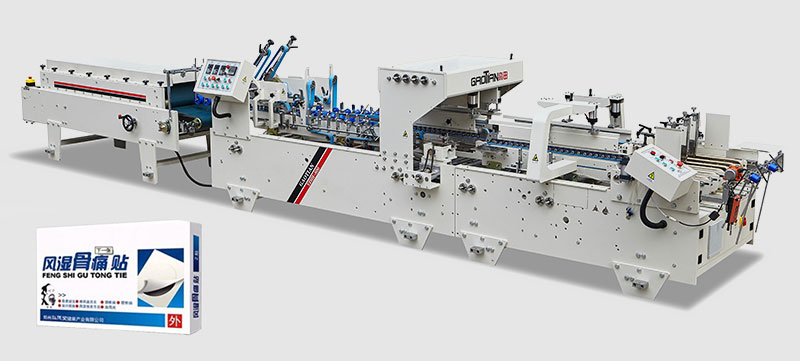The Role of Folder Gluer Machines in Rigid Box Manufacturing
A folder gluer machine is a pivotal automated device in rigid box (lid-and-base box) production, designed to fold and glue die-cut paperboard into structured, three-dimensional box bodies and lids. By replacing up to 80% of manual labor, it ensures precision, consistency, and efficiency in creating high-end packaging, particularly critical for luxury goods where structural integrity and aesthetic appeal are paramount.
Core Functions in Rigid Box Production
Rigid boxes consist of separate base and lid components, requiring strict control over folding accuracy (±0.3mm tolerance) and adhesive strength. Folder gluers achieve this through three key processes:
1. Material Handling & Alignment
- Heavyweight Material Compatibility: Processes paperboard ranging from 350–1,500 gsm, including greyboard, density board, and laminated composite sheets (e.g., cardboard-faced greyboard). Vacuum suction or servo-driven feed systems flatten and align sheets to prevent warping during folding.
- Precision Positioning: Optical sensors detect registration marks on pre-printed or decorated boards (e.g., foil-stamped, UV-coated materials), ensuring fold lines align perfectly with die-cut contours.
2. Customized Folding Mechanisms
- Box Body Formation: Adjustable folding plates and pressure rollers create 90° vertical folds for the base, reinforcing corners with locking or wrapping structures to support heavy contents. Production speeds typically range from 600–1,200 units per hour for standard designs.
- Lid Fabrication: Specialized tools widen folding margins and apply secondary pressure to form slightly flared lid edges (2–3mm outward curl), ensuring smooth nesting and preventing jamming when the box is closed.
3. High-Strength Adhesive Application
- Targeted Glue Placement: Uses slot nozzles or mesh rollers to apply heat-resistant adhesives (e.g., hot-melt glue, water-based polyurethane) in 0.4–0.6mm beads along box corners and lid interiors, avoiding decorative surfaces.
- Controlled Curing: Pressure rollers (50–150N force) secure glued sections, achieving initial bond strength within 10–15 seconds to ensure joints withstand stacking pressures without separation.
How Do Specialty Materials Impact Folder Gluer Performance?
Laminated and shaped materials require technical adjustments to maintain quality:
- Laminated Composite Boards (e.g., 2mm greyboard with 157g art paper veneer):
-
- Dual-guide roller systems balance tension between rigid cores and flexible outer layers, reducing wrinkling. Glue application increases by 30% to compensate for adhesive resistance in multi-layer structures.
-
- Folding speed is reduced to ≤800 units/hour, with servo motors dynamically adjusting pressure to prevent tearing of thin decorative layers.
- Curved/Irregular Shapes:
- Customizable 3D folding dies and vision-guided systems adapt to arcs or beveled edges, slowing production to 400 units/hour to ensure smooth, crease-free curves. Surface treatments like corona discharge may pre-treat glossy films (e.g., PET laminates) to enhance glue adhesion by 40%.
How to Integrate Folder Gluers with Post-Production Equipment?
Seamless automation boosts efficiency in premium box manufacturing:
- Corner reinforcement system: After the folder gluer forms the box body, the PLC-controlled conveyor belt directly transfers it to the corner filling machine, which uses silk or PU to reinforce the corner piece. This reduces damage caused by manual handling and speeds up the workflow by 30%.
- Decorative Process Coordination: For foil-stamped lids, non-contact air-cushion feeders replace rubber belts to avoid scratching delicate surfaces (reducing defect rates from 5% to 0.3%). Folding pressure is decreased by 20% to prevent foil cracking, with glue applied 3mm away from decorative areas.
Key Considerations for Optimal Operation
Material-Equipment Matching
- Thickness Tolerance: Ensure the machine’s feed and folding systems accommodate your board’s weight (e.g., heavy-duty rollers for ≥500 gsm materials to prevent indentation).
- Surface Sensitivity: Use non-marking components (e.g., silicone-coated rollers) for UV-varnished or laminated boards to avoid surface marring.
Quality Control Metrics
- Vertical Alignment: Measure with a right-angle gauge; deviations >1° can cause lid misfit and reduce perceived quality.
- Adhesive Spillage: Maintain ≤5% spillage by calibrating nozzle height (2–3mm above bonding surfaces) and air pressure (0.3–0.5MPa).
- Edge Smoothness: Clean folding rollers daily to remove paper dust, ensuring burrs <0.5mm to prevent user injury during unboxing.
Conclusion
Folder gluer machines transform rigid box production from a labor-intensive craft into a scalable, precision-driven process, essential for meeting the demands of luxury packaging. Success lies in understanding material interactions (e.g., laminate tension, adhesive compatibility) and optimizing machine settings for both standard and custom designs. By prioritizing seamless integration with post-press equipment and rigorous quality control, manufacturers can deliver rigid boxes that balance industrial precision with artisanal elegance, ensuring competitiveness in high-end markets.





